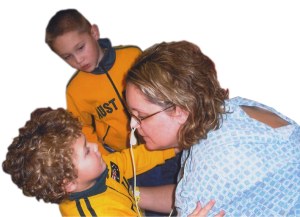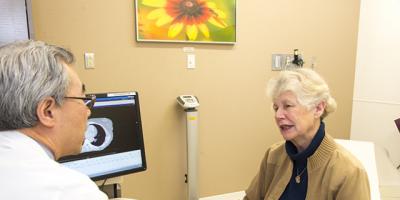A different stroke: Hers happened after a neck adjustment

Carmella Carroll, seven years after a stroke. (PHOTO BY ROBERT MESCAVAGE)
In seeking relief for tension headaches, Carmella Carroll sought treatment that – she later learned – increased her risk for a stroke.
The Manlius woman was 33 in October 2009 when she went to a chiropractor for a neck adjustment. She wound up spending more than 20 days hospitalized and months in rehabilitation after suffering a type of stroke called a vertebral artery dissection.
It‘s a rare but serious injury, says Lawrence Chin, MD, the chairman of Upstate‘s neurosurgery department. “I‘ve seen it happen,” he says. The vertebral arteries thread through the vertebrae of the spine on each side of the neck. They can be damaged through spinal manipulation, leaving small tears in the inner lining of the arteries. Blood clots can develop and travel to the brain, causing a stroke.

Carroll's sons visit her in the hospital, shortly after her 2009 stroke.
Carroll remembers the last time she left her chiropractor‘s office, feeling groggy and almost intoxicated. Once home, she lay down to calm her dizziness. She was vaguely aware of carving pumpkins with her husband and their children, who were 2 and 4 at the time.
Her equilibrium remained strange when she got up the next morning. As she drove to work, Carroll‘s vision began to dim. She pulled over, and she threw up. She called for help through her vehicle‘s security system. She lost sensation on her right side, and her vision. Her face drooped, and her speech became slurred.
She did not know what was happening. “I just remember there was a lot of chaos,” she recalls. “The reality is, if I didn‘t get help soon enough, I was going to die.”
Both of her vertebral arteries were affected. Carroll says doctors immediately placed a stent inside one of the arteries, as reinforcement. After she was stabilized, they placed a stent on the other side.
She was in the intensive care unit for five days and had a difficult time regaining her health, although her vision was restored. For the first two weeks, Carroll couldn‘t swallow, and for months after she could only eat soft foods. She walked with a cane when she left the hospital, and her home had to be modified with ramps and stairs that helped her reach her bed.
Carroll worked with occupational and physical therapists and audiologists during her rehabilitation. “Each time things would get a little bit easier, I would start to see this ray of hope.”
Seven years later, she is grateful for her health. She has a new husband, a third child, plus two stepchildren. She still has trouble eating some foods. When she is tired, her speech slurs. Her temperature regulation is sometimes off. But her headaches are under control, with medication.

 This article appears in the summer 2016 issue of Upstate Health magazine. Hear radio interviews about various aspects of stroke -- how to recognize one; how today's treatment is rapid and minimally invasive; the surgical options; the relationship to atrial fibrillation; support groups; and how emergency response is coordinated throughout the region.
This article appears in the summer 2016 issue of Upstate Health magazine. Hear radio interviews about various aspects of stroke -- how to recognize one; how today's treatment is rapid and minimally invasive; the surgical options; the relationship to atrial fibrillation; support groups; and how emergency response is coordinated throughout the region. 



